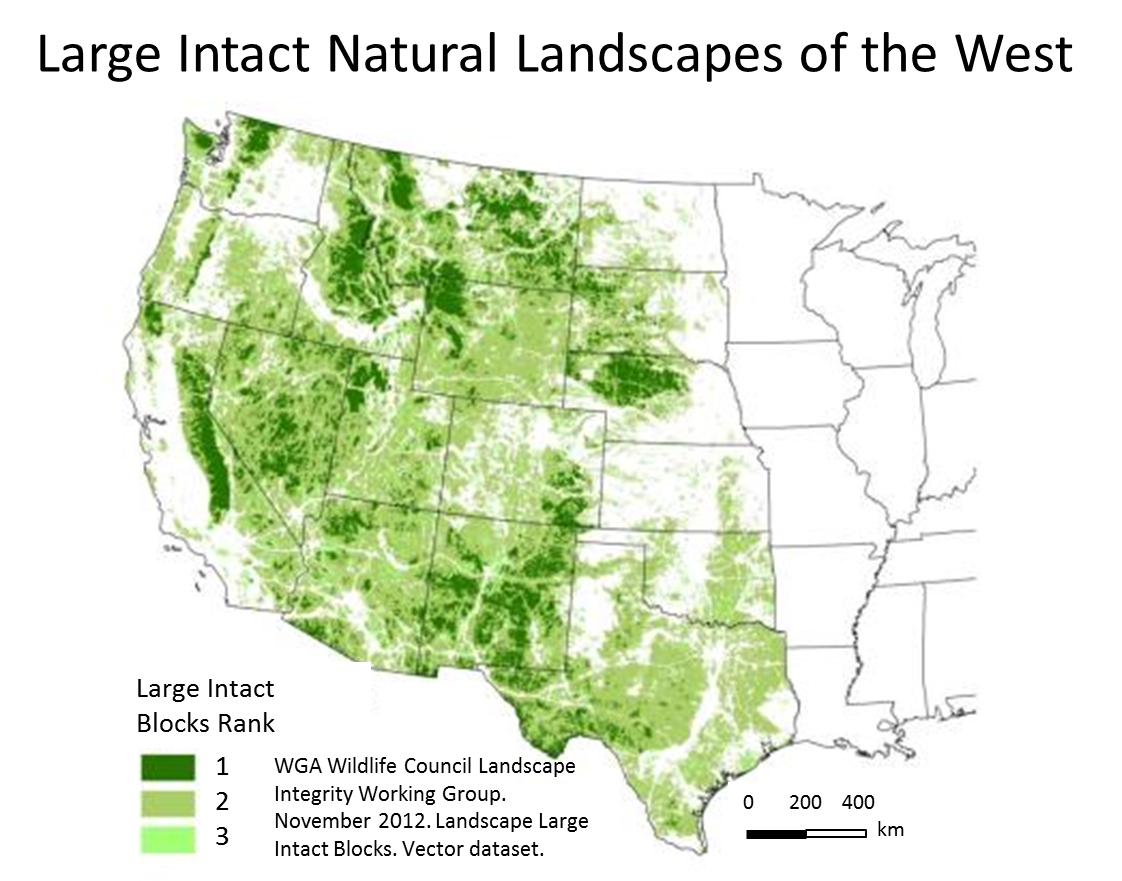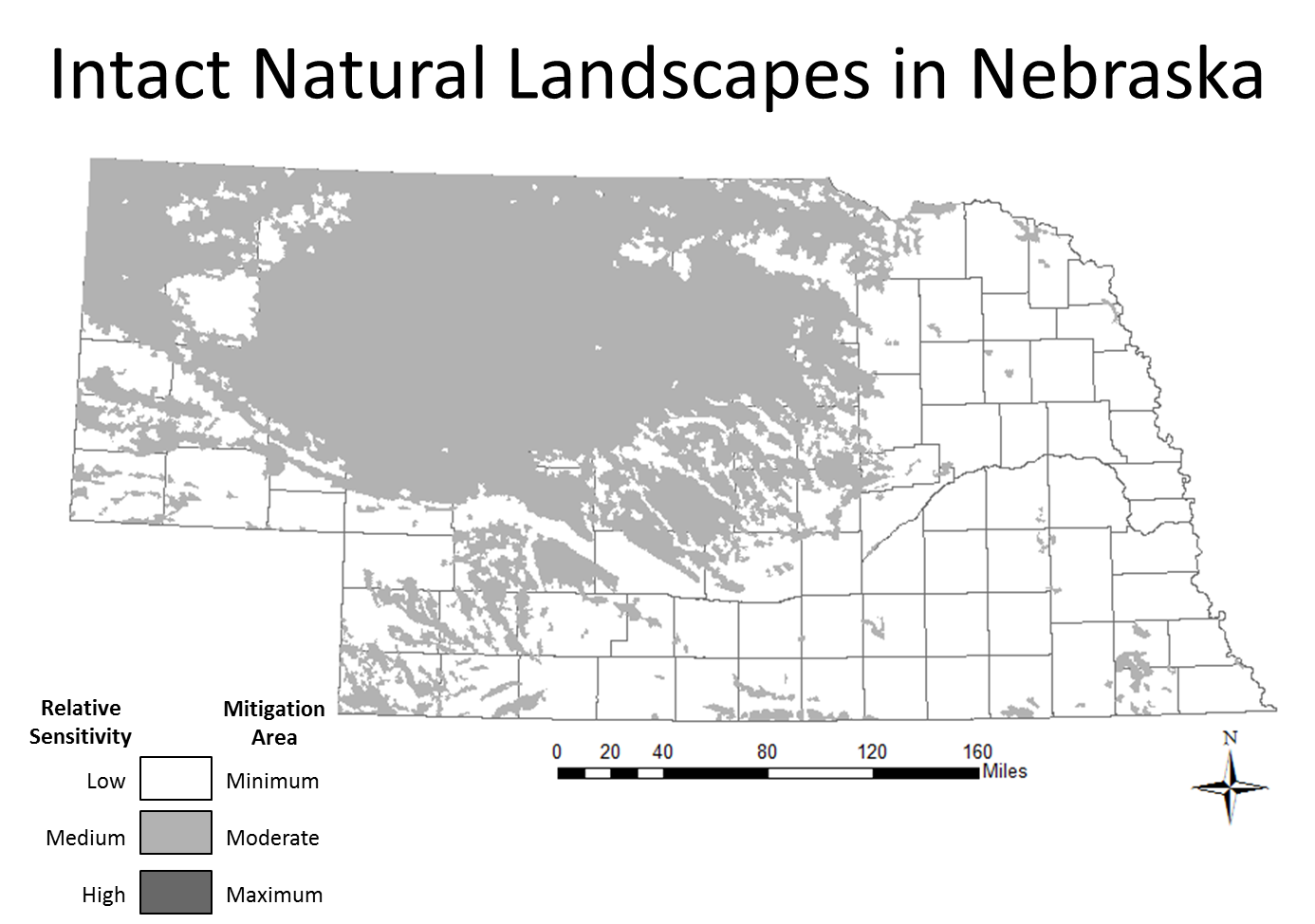Intact Natural Landscapes in Nebraska
Obermeyer et al. in their 2011 paper, Development by Design: Mitigating Wind Development's Impacts on Wildlife in Kansas, used two categories of intactness to describe unfragmented landscapes, 50-95% grassland cover and > 95% grassland cover. For Nebraska, a similar methodology was used, but included all intact native lands instead of only grassland cover.
Mitigating Wind Development's Impacts on Wildlife in Kansas, used two categories of intactness to describe unfragmented landscapes, 50-95% grassland cover and > 95% grassland cover. For Nebraska, a similar methodology was used, but included all intact native lands instead of only grassland cover.
The layer used is the intact blocks developed by the landscape integrity workgroup of the Western Governors' Association (WGA) Crucial Habitat Assessment Tool (CHAT) technical team (WGA Wildlife Council Landscape Integrity Working Group. November 2012. Landscape Large Intact Blocks. Vector Dataset.). The Large Intact Blocks (LIB) dataset was calculated from the NatureServe Landscape Condition Model (Comer, P. J. & J. Hak. 2012. Landscape Condition in the Conterminous United States. Spatial Model Summary. NatureServe, Boulder, CO) as a way to identify large areas that were relatively intact or had low levels of anthropogenic impacts. A minimum LIB size was set at 1,000 hectares, but the threshold for impacted varied by ecodivisions to account for regional differences. Areas with a rank of 1 are the highest quality intact blocks for the ecoregion.
For use in this document, the data layer was slightly modified to include small areas under two square miles that were not part of intact blocks but were completely inside intact blocks.
The Sandhills
The Sandhills is the most intact landscape left in the Great Plains and is one of the highest quality, intact prairie landscapes in the country (Schneider et al. 2011). The importance of the intact Sandhills for conservation of biodiversity at a global level is underscored by the fact that they harbor globally imperiled species such as American burying beetle (Nicrophorus americanus, G2G3), Hall's bulrush (Schoenoplectus hallii, G2G3), and regal fritillary (Speyeria idalia, G2), as well as species in decline elsewhere such as greater prairie-chicken (Tympanuchus cupido, G4) and Blanding's turtle (Emydoidea blandingii, G4).
The Sandhills is the most important breeding area for mallards (Anas platyrhynchos), blue-winged teal (Anas discors), and northern pintails (Anas acuta) south of the prairie pothole region (Schneider et al. 2011). The Sandhills is an important nesting area for the long-billed curlew (Numenius americanus) (e.g., Gregory et al. 2012), a species considered highly imperiled by the U.S. Shorebird Conservation Plan.  The region is also an important nesting area for American avocet (Recurvirostra americana), willet (Tringa semipalmata) and Wilson's phalarope (Phalaropus tricolor) and an important staging and stopover area for American avocet, Baird's sandpiper (Calidris bairdii) and Wilson's phalarope and other shore- and waterbirds.
The region is also an important nesting area for American avocet (Recurvirostra americana), willet (Tringa semipalmata) and Wilson's phalarope (Phalaropus tricolor) and an important staging and stopover area for American avocet, Baird's sandpiper (Calidris bairdii) and Wilson's phalarope and other shore- and waterbirds.
There are several specific areas in the Sandhills which are more sensitive to wind energy development and are considered High Relative Sensitivity and Maximum Mitigation Areas. These areas are described in the following sections.
How this map was used: All areas classified as Ranks 1 and 2 in Nebraska were classified as Medium Relative Sensitivity and Moderate Mitigation Areas.